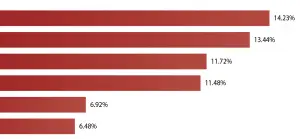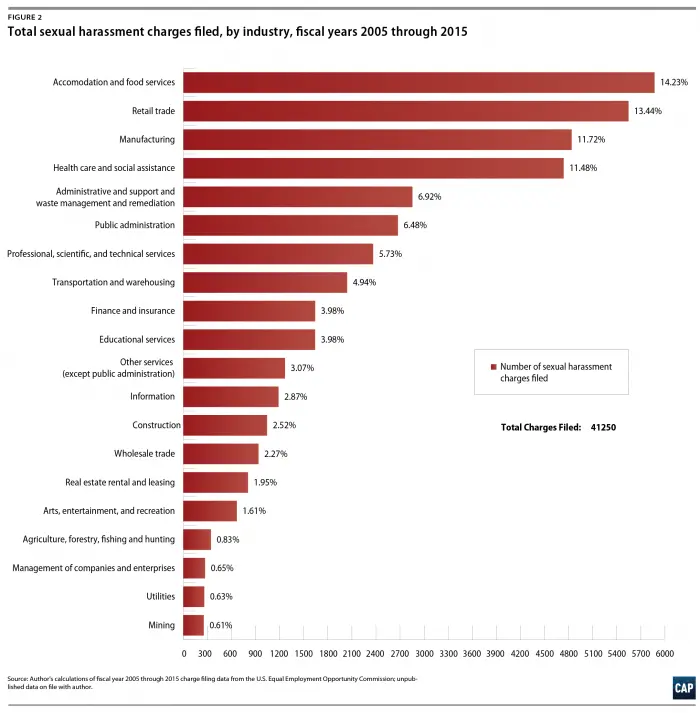
Workplace Sexual Harassment by Industry
January 8, 2019
EEOC data demonstrates a connection between sexual harassment and wages
Genevieve Carlton, Ph.D
Sexual harassment in the workplace remains a problem in every industry. From minimum wage workers to journalists and actresses making millions a year, millions of men and women face sexual harassment at work every year. Federal laws protect employees from workplace sexual harassment, which employees can report to the Equal Employment Opportunities Commission (EEOC).
The EEOC issues reports on workplace sexual harassment claims filed with their agency. This data shows that some industries report more instances of sexual harassment than others. The patterns in the EEOC data show a critical connection between sexual harassment and wages.
Sexual Harassment Occurs In Every Workplace
Data from ten years of EEOC workplace sexual harassment reports analyzed by the Center for American Progress shows that sexual harassment occurs in every industry. Between 2005 and 2015, the EEOC processed over 85,000 sexual harassment reports, and nearly half of these claims listed the industry where the offense occurred. This data covers private sector sexual harassment claims.
In addition to sexual harassment, the EEOC also enforces employment discrimination laws, including Title VII of the Civil Rights Act of 1964. The act prohibits workplace discrimination based on sex, race, and national origin. Sexual harassment makes up a major part of the EEOC’s work. In 2016, of the 90,000 charges filed with the EEOC, nearly one-third reported harassment, with half that number involving sexual harassment.
The Largest Claims of Sexual Harassment by Industry
The largest number of sexual harassment claims came from the restaurant and hospitality industry. The claims came from employees at restaurants, hotels, and coffee shops. From 2005 to 2015, the restaurant and hospitality industry accounted for 14.23% of all sexual harassment claims filed with the EEOC.
A survey of sexual harassment in the restaurant industry found that two out of three restaurant employees experienced sexual harassment from management. Even more employees reported sexual harassment by coworkers and customers. The data also indicated that restaurant workers in lower-paid states faced higher incidents of sexual harassment.
The EEOC data indicated that retail ranked as the second-worst industry for sexual harassment, with 13.44% of EEOC sexual harassment claims coming from retail workers.
Other Industries With High Sexual Harassment Claims
In addition to restaurant, hospitality, and retail claims, 11.72% of all sexual harassment claims came from the manufacturing industry, while 11.48% came from the healthcare and social services industry. No other single industry represented more than 7% of the claims, including administrative and support positions, public administration, and transportation.
As the Center for American Progress concluded, over a quarter of sexual harassment claims came from industries that rely on service-sector employees. These industries employ a large number of women working in low-wage positions. The study also found that women filed 80% of sexual harassment claims. While women made up the majority of sexually harassed workers, many men also faced sexual harassment at work.

Center for American Progress chart on sexual harassment by industry, 2005-2015
Explaining the Workplace Sexual Harassment by Industry Patterns
The industries with the highest number of sexual harassment claims employ high numbers of women. According to the Bureau of Labor Statistics, over half of all workers in the accomodation and food services sector are women, while just under half of retail workers are women. These industries also employ women in low-paying jobs, such as fast food workers, cashiers, housekeepers, and servers.
However, some industries dominated by women reported many fewer claims of workplace sexual harassment. Over 68% of employees in the education sector, for example, are women, but the field made up less than 4% of EEOC sexual harassment claims. Significantly, educators earn higher salaries than most restaurant, hospitality, or retail workers.
The data suggests that women earning low salaries may face an increased risk of sexual harassment. While high income women who report sexual harassment, such as actresses and journalists, appear more visible to the public, millions more women face workplace sexual harassment with little public attention. According to a 2018 survey, 38% of women reported that they have experienced sexual harassment at work.
Conclusions About Sexual Harassment By Industry
The 85,000 reports of sexual harassment filed with the EEOC between 2005 and 2015 shed light on the pervasiveness of workplace sexual harassment in all industries. However, certain workers are more likely to face sexual harassment at work.
Women working in lower-paid jobs, particularly in the service industry, are more likely to experience workplace sexual harassment. In industries like food service, hospitality, and retail, women experience power imbalances that makes it even more dangerous to speak out against sexual harassment. Nearly 75% of the EEOC sexual harassment claims also reported retaliation, including wrongful termination. The threat of losing a job can make victims of sexual harassment afraid to come forward.
While workplace sexual harassment affects millions of employees, federal, state, and local laws provide sexual harassment protections. Victims of sexual harassment can file an EEOC complaint or contact a lawyer for a free consultation.
Contact New York employment lawyer Charles Joseph for a free consultation. Find out if you have a case today.